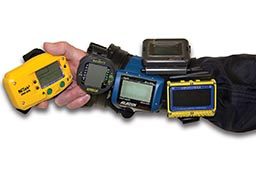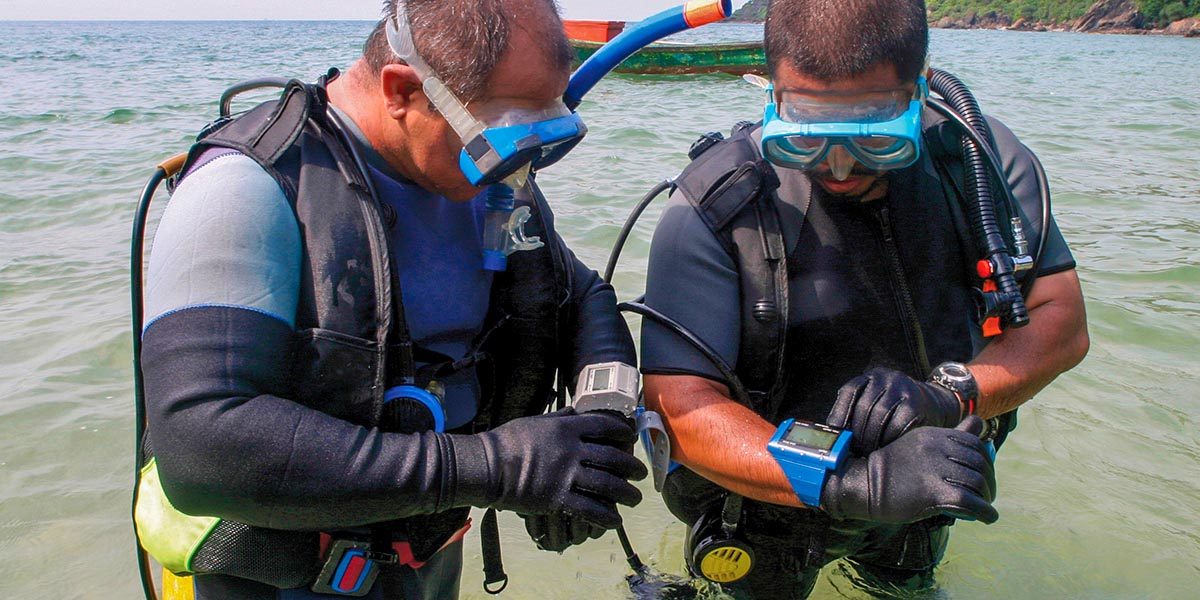“Divers are surprised when symptoms of DCS develop after dives that appeared safe according to their dive computers. Remember, models reflect an average diver, not you.”
In recent years, dive computers have supplanted dive tables as the primary means of regulating dive profiles. Dive computers offer an advantage in that they enable the diver to dynamically establish different compartments as the controlling compartment, as conditions change during a dive. In reality, the compartments in a dive computer’s modeling software do not have to represent any particular tissue, as long as the guidance provided by the model results in an acceptable outcome — specifically, very little DCS.
In this chapter, you’ll learn:
Précautions importantes

While the guidance provided by decompression models can be very useful, it is important for divers to keep in mind that dive schedules — whether they are presented in printed tables or on the screen of a dive computer — are limited in what they measure and in the assumptions upon which the model was constructed. Tissue compartment parameters can be adjusted, or new compartments can be added to an algorithm, if experience shows deficiencies in a given model — but in real time, the calculations are limited by the variables that are being processed. Algorithms can estimate limits based on time and pressure (depth) profiles for a given breathing gas, but they are not able to compute the impact of myriad real-time factors, including thermal status, exercise intensity, joint forces and a host of individual predispositions that are currently not well understood, let alone quantifiable in their impact on decompression stress.
Divers are often surprised when symptoms of DCS develop after dives that were conducted within the limits of their dive computers. It is important to remember, though, that while mathematical models predict outcomes, they do not guarantee them. The fact that a dive was conducted within the limits suggested by a dive computer (or a dive table) does not make a DCS hit “undeserved.” The mathematical algorithms provide guidance that must be evaluated and tempered by a thoughtful diver.
De nombreux plongeurs ignorent également que les ordinateurs de plongée utilisent de nombreux modèles mathématiques différents, ou des versions de différents modèles ; il n'existe pas de norme universelle. Un même fabricant peut même utiliser plus d'un modèle, éventuellement dans un seul type d'ordinateur. Il est donc extrêmement difficile d'évaluer les nuances de chaque système.
Lignes directrices de base
There are some basic guidelines that can help to ensure the safe and effective use of a dive computer. The following considerations are intended to offer a somewhat light-hearted insight into what your dive computer can — and cannot — do.
Il est utile de penser à votre ordinateur de plongée de cette manière :
- En tant que concurrent de l'entreprise : Maîtrisez-le en apprenant ses forces et ses faiblesses.
- En tant que rendez-vous : il doit être activé pour que la relation fonctionne.
- En tant que compagnon : il doit descendre et remonter quand, et seulement quand, vous le faites.
- En tant qu'assistant personnel : il vous rappelle les règles et les horaires que vous risquez d'oublier.
- En tant qu'acteur : Il récite les répliques sans avoir à en comprendre les implications.
- En tant qu'homme politique : Ne croyez pas tout ce qu'il vous dit.
- As a hotel concierge: It will help you do what you want — but at a price.
- En tant qu'étranger : il ne sait pratiquement rien de votre réalité personnelle.
- En tant que partenaire : Est-il compatible avec vos amis ?
- En tant que journaliste : il diffusera votre linge sale.
- En tant qu'outil : Utilisez-le de manière appropriée.
Conseils et astuces spécifiques
Appuyer sur les bons boutons
Vous devez savoir non seulement quels boutons appuyer pour faire fonctionner votre ordinateur, mais aussi quel modèle mathématique ou quelle dérivation de modèle il emploie pour effectuer ses calculs de décompression. Il existe une gamme surprenante de modèles, allant du conservateur au libéral, et ces différences peuvent ne pas être évidentes à première vue. Par exemple, un ordinateur peut établir des limites conservatrices pour une première plongée, mais des limites libérales pour des plongées répétées. Il est préférable de s'informer suffisamment sur les différents modèles et dérivations disponibles avant de choisir un ordinateur de plongée, afin d'être sûr de choisir un ordinateur compatible avec votre propre niveau de tolérance au risque. Choisir un ordinateur de plongée en se basant uniquement sur la familiarité n'est peut-être pas la meilleure stratégie. Même si vous avez obtenu de bons résultats lors de vos précédentes plongées avec un ordinateur, cela ne garantit pas qu'il sera le meilleur pour vos futures plongées. Accumuler des connaissances demande de l'engagement, mais une planification éclairée de la sécurité en matière de décompression doit être une préoccupation majeure.
Se brancher et s'allumer
Failing to turn on your dive computer (or to take it with you on a dive) may sound like a joke, but it does happen and can create real problems. No computer can factor in the exposure profile of a previous dive if it was not there. And any decompression model is invalid unless you start using it when you are “clean” — fully off-gassed from any previous dives. If you forget to take your computer with you on a dive early in a repetitive series, you are then restricted to using tables for the duration of that series (assuming that you are able to manually compute the exposure of the unmonitored dive). And do not even think about hanging your computer on a downline during a surface interval in an effort to compensate for having forgotten it on an earlier dive; there may be stories about that happening, but it is not a responsible practice.
L'utiliser à bon escient
The only person who does not have to worry about taking a dive computer on every dive is the one who uses it solely as a datalogger — that is, only to record time and depth information instead of to calculate decompression profiles. Remember, however, that using your computer simply to log your time and depth data means that you must still plan all your dives using dive tables and must recompute your repetitive group status afterward, as appropriate. You cannot move in and out of relying on your computer’s decompression computations unless it has recorded all of your exposure profiles.
N'oubliez pas ses limites
Dive computers are wonderful at carrying out programmed mathematical computations, but they are blind to the many insights you may have before, during and between your dives. For example, your dive computer knows nothing about your personal health status, your level of physical fitness or your individual susceptibility to decompression stress. It also knows nothing about your thermal stress or physical efforts during or between dives. The fact that many dive computers display water temperature might suggest that thermal stress is factored into the device’s algorithms. A water temperature reading, however, provides no useful information regarding thermal stress, since the diver carrying the device could be wearing anything from a bathing suit to a wetsuit without a hood to a cold-water drysuit with a hood, gloves and cold-water undergarments. More important, it is not yet possible to directly compute the impact of differences in thermal status during different parts of a dive, even if the computer was able to measure the diver’s core temperature and skin temperature in key spots.
We do know that being warm (rather than cool or cold) during the compression and bottom phase of a dive promotes inert gas uptake (not optimal), and that being warm during the decompression phase promotes elimination (optimal). While impractical for the comfort-loving diver, decompression safety is optimized by being neutral or cool during the inert gas uptake phase of descent and bottom time and warm during the inert gas elimination phase of ascent. While the concept of thermal changes on decompression stress is clear, we are still years away from being able to quantify the real-world effects of these factors for dive-planning purposes. Similarly, while some computers are able to track gas consumption, we have much to learn before this information can be meaningfully incorporated into decompression models. Variations in air consumption can reflect differences in the depth of a dive or in the diver’s experience, level of anxiety or degree of physical exertion. The bottom line is that interpreting the precise physiological impact of the interactions among these diverse factors is exceedingly difficult, requiring thoughtful practice by divers.
Heed Your Computer’s Readings
Divers need to pay attention to their dive computers if the information provided is to be of any use. Be aware that confirmation bias can promote risky behavior. “Getting away with” a risky exposure once, twice or even many times may eventually catch up with you. It may not truly be safe for you or for a partner who might have a higher degree of susceptibility to decompression stress. Those who wish to worry less about their exposure will have greater peace of mind if they choose a computer that employs an extremely conservative decompression model. It is also important to pay attention to your dive computer. If you are diving with a group, do not forget that there can be considerable variability in the guidance provided by different computers or computers with different user-selected settings. That means there is considerable benefit in diving with others who use a computer with a similar decompression model and settings, because if modest discrepancies arise, following the most conservative directive will likely not be terribly burdensome for the group. But if members of a group are using dive computers with substantially different models, and each diver wishes to follow his or her own device, it can lead to a breakdown in the buddy system.
Ne vous fiez pas aveuglément à votre ordinateur
Although heeding your computer is important, do not take its advice unthinkingly. The same profile can sometimes be conducted without problem again and again, right up to the dive where it does not prove safe. Divers often try to blame a specific factor, such as dehydration, for the development of symptoms following one dive but not another. This approach is not productive. The range of variables in play during a dive are rarely identical, and there is a probabilistic element to decompression risk — that is, chance can play a role in the manifestation of DCS.
La meilleure approche consiste à éviter les extrêmes que sont la résignation fataliste ou la focalisation suffisante sur une seule solution supposée magique. Il existe de très nombreuses petites mesures que vous pouvez prendre pour rendre vos plongées plus sûres. La plus importante est de rester dans un profil de temps et de profondeur raisonnablement conservateur et d'ajouter des paliers de sécurité à chaque plongée. D'autres mesures importantes consistent à minimiser l'intensité de l'exercice et à éviter la surchauffe pendant la phase d'absorption des gaz de la plongée, à choisir le bon gaz respiratoire, à s'entraîner suffisamment pour être capable de contrôler parfaitement sa flottabilité, à rester bien reposé et bien hydraté, à choisir des réglages plus conservateurs sur l'ordinateur et à plonger avec un partenaire qui a les mêmes objectifs et qui suit les mêmes pratiques. L'ajout de petites marges de sécurité à chaque étape peut contribuer à créer un coussin de sécurité confortable. Les ordinateurs de plongée sont des outils puissants, mais une bonne connaissance de la physiologie de la plongée, une bonne condition physique et le respect de pratiques réfléchies constituent la meilleure protection pour les plongeurs.
Gardez-le avec vous
Si vous présentez des symptômes de DCS, vous devriez garder votre ordinateur avec vous lorsque vous vous rendez à un examen médical. Certains établissements peuvent avoir la possibilité de télécharger ou de consulter votre profil pour faciliter l'évaluation de votre cas. Le personnel médical appréciera certainement de voir la confirmation de votre description des événements qui ont précipité vos symptômes.


